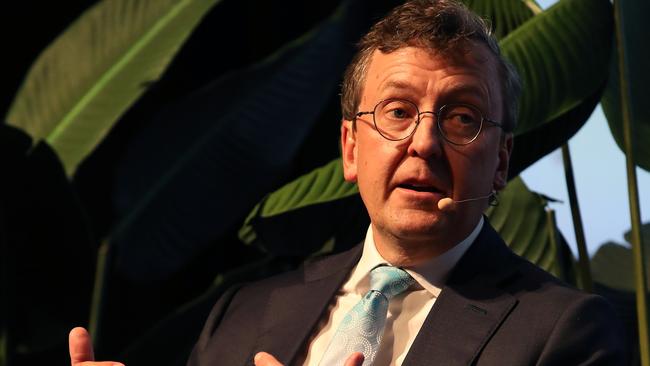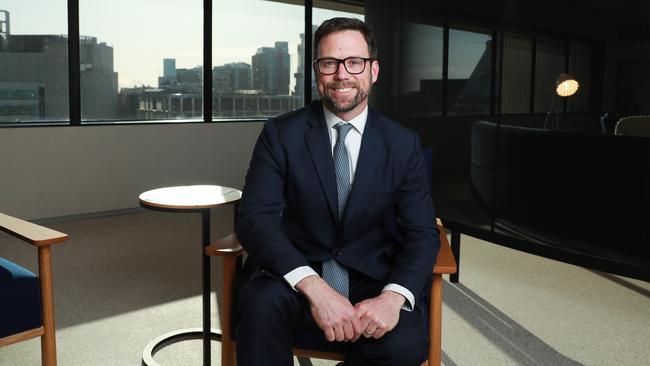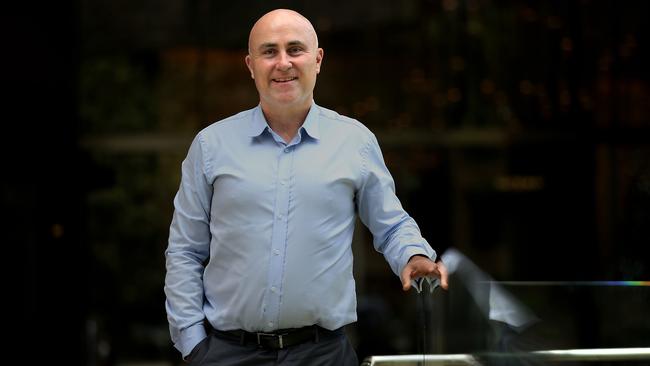How fundies plan their turnaround of fortunes
Morningstar data shows not a single listed active manager covered by the research house recorded a positive total return in 2022.

After years of outflows, Platinum Asset Management’s Andrew Clifford hopes 2023 will mark the start of a much-needed turnaround. His approach is to keep doing more of the same.
At Magellan Financial, chief executive David George has big ambitions to get the under-pressure fund back to its glory days. He’s looking for bolt-ons and eyeing new products in a bid to double funds to $100bn.
While pursuing different strategies to reignite investor confidence, both are acutely aware that flows won’t improve until performance does.
On this front, Platinum is ahead of its rival, thanks to the market turn against growth stocks. The globally focused value manager’s international fund beat its benchmark by 16 per cent over the year to December 31, returning 3.1 per cent as the index limped in with a negative 12.5 per cent. Magellan’s flagship global fund, meanwhile, returned negative 15 per cent.
Even with Platinum’s short-term bump in performance, there’s no doubting the shine has long come off these once-lauded money managers as lengthy periods of poor returns translated to masses of redemptions.
They’re not the only ones battling for relevance in a world of intense competition, rising costs, and a glut of cheap, easy-to-access – and increasingly smarter – passive investments. Fund managers across the board continue to fight structural forces that have battered the industry for years. In the era of easy money and easy returns, it was a near impossible task to outperform the market to any great extent.

As the market turned, advocates argued active managers would shine in 2022. For many, including shareholders in the listed investment houses, it ended up being a year to forget, with negative share price moves across the board.
According to Morningstar data compiled for The Weekend Australian, not a single ASX-listed active manager covered by the research house recorded a positive total return – share price and dividends – in 2022 and Magellan was the worst of the lot with a negative 53 per cent return.
But an uptick in recent weeks gives some hope that 2023 may be different. For now, at least, Platinum is leading the charge, with its share price surging 21 per cent since the start of the month.
Still, Mr Clifford, also co-founder and co-chief investment officer of ASX-listed Platinum, is keeping his optimism in check. “It will take some time for the marketplace to realise just quite how good our numbers are,” he said.
“So, an immediate turnaround? Perhaps not in the first half of the year, but as the year progresses, I would, consistent with history, expect there to be an improvement in flows.”
Unlike some of his peers, Mr Clifford said he has no plan to shift strategy or overhaul his investment team to boost performance. Instead, he was focused on the fund’s point of difference: staying away from the crowded plays.
While keeping a steady pace, there’s no doubt Mr Clifford will be looking over his shoulder amid talk his fund is ripe for a takeover. (Even with the recent share price bump, the stock is still trading near its all-time lows.)
Morningstar analyst Shaun Ler said the fund manager was attractive at its current valuation and would appeal to some in the market. “It would be a noteworthy target. It’s cheap, its performance is showing signs of improvement and it also manages higher-margin retail money,” Mr Ler said.
“So it could be a good play for a manager looking to expand their offering to include international equities, with a slicker client base.”
Mr Clifford, for his part, is not convinced the M&A strategy pursued by others in the industry is the answer.
“All the companies involved in this (M&A) activity, we are all suffering from the same dynamics in the industry. And the issue is, when you have M&A, do you solve the problem? I would question whether you do,” he said.

“When managers talk about scale, you’ve got to stop and think about the likes of Fidelity, Blackrock, Vanguard. They have $10 trillion or so in assets under management. That’s scale. Not a couple of hundred billion.”
On the other side of the field is ASX-listed growth manager Magellan, which is sitting on funds under management of $45bn, less than half of what it was managing 12 months ago, on the back of a dismal performance and an implosion at the top as chief stockpicker Hamish Douglass staged a protracted exit.
But Mr George, who has been at the helm of Magellan since May, has big plans to recover those lost funds in the coming years, through a strategy of improving performance, bulking out the offerings and scooping up other players.
Admitting that $100bn is “a big number”, Mr George said he wasn’t tied to it. Nor is he willing to pursue bolt-ons for the sake of it.
“Acquisitions in people businesses, which these are, they’re not things you can enforce very strict plans around. You’ve got to look for things that work and things that fit,” he told The Weekend Australian. “I think (acquisitions will be) a part of the strategy over time, in part because we want to evolve for where our clients and the markets are going.
“And $100bn as a number, I feel confident that makes sense and has achievability. But if no acquisitions arise or those opportunities aren’t right then we wouldn‘t force something in order to hit (it).”
Mr George’s appointment to the top job at the money manager came after his predecessor Brett Cairns shocked the market with his departure in December 2021, followed shortly thereafter by Mr Douglass, who took an extended leave of absence before exiting for good. In the midst of this, the fund manager lost UK-based St James’ Place as a client, with $20bn out the door ahead of a steady flow of redemptions through the year.
In a bid to restore investor confidence, stem the outflows, and move past the Dougless-led era, there has been a deliberate move to bring Magellan back to its roots, Mr George said. “One of the key changes – and this was happening through the course of 2022 – was just refocusing Magellan around funds management as the core business. I think that (change) creates the best performance outcomes and makes the most sense for our clients and shareholders.”
In its flagship Global Fund, it has also reduced its exposure to cyclicals in the portfolio while increasing its cash position, as it takes a more defensive approach.
Longer term, Mr George is eyeing new offerings he said would see the money manager evolve and adapt to changing client needs. “We’re following our clients, in particular into areas where their portfolios are growing, or ways that they want to invest going forward,” he said. “They want to invest in more ESG-oriented strategies and responsible investing. They are concerned and, in a lot of cases, have made quite explicit commitments around climate change and targets and the like. Those are areas where we actually have relevant experience.”
Mr George sees acquisitions as a key driver of growth. Like others in the sector, he speaks of the benefits of scale and diversity.
Consolidation in the funds management industry is not new, but it has been a hot topic as some of the biggest players laud the benefits of tie-ups to fight off the sector’s many challenges.
Pendal has already merged with another listed house, Perpetual, with the latter’s chief executive Rob Adams calling out the scale benefits as one of the reasons for the takeover.

Meanwhile, Regal Funds Management’s Phil King has pointed to Platinum as a potential target.
EY has tipped a pick-up in M&A in the year ahead in its latest wealth and asset management sector outlook. “With pressure on returns, margins and profitability impacted by market conditions, and scale and consolidation seen as key answers, 2023 will continue to see mergers and acquisitions activity in the asset management industry,” EY Oceania’s wealth leader, Rita Da Silva, said.
As Platinum and Magellan, among others, nurse their wounds and faithfully await a turnaround in flows, a newer player in the local market is reaping the benefits.
US-based GQG Partners, in operation since 2016, opened its Australian office in 2019 and listed on the ASX in October 2021. With $US88bn in global funds under management, the active manager has grown its Australian and New Zealand FUM from $2bn to $8bn in four years. Around 80 per cent of that is from institutional investors, with wholesale making up the remaining 20 per cent.
The firm was one of the strongest performers for inflows over 2022, giving it good momentum, according to its Australia managing director Laird Abernethy.
“The (pace of) inflows starts and ends with performance – delivering performance at a lower volatility to our competitors and delivering better risk-adjusted returns too,” Mr Abernethy said.
“That said, you do need a strong distribution capability to ensure that performance can translate into flows. At GQG we have a very strong global distribution capability,” he said.
For the first 11 months of the year, GQG’s Global Equity Fund, available to Australian investors, returned 4.8 per cent versus the benchmark’s negative 7.9 per cent. But it still saw a negative share price performance over the period, with the stock down 20 per cent for the year.
“With the performance that we‘ve delivered and the competitive pricing point for our strategies in this market, I think we’re in really good stead to attract flows from (institutional and wholesale clients),” Mr Abernethy said.
As active managers fight for investor funds, there is no ignoring the greater threat posed by the passive investing juggernaut.
Morningstar data shows that passive funds received $10bn of inflows over 2022, while actively managed funds saw $23bn of outflows over the same period.
And the dangers are only growing, Morningstar‘s Mr Ler warned. “(The industry) is scared because you’ve got passive investments that are getting scale … but they’re also becoming increasingly intelligent,” he said. “You can now invest (in ETFs) based on a few factors that can really replicate what the fund managers are doing, for a lower price.”




To join the conversation, please log in. Don't have an account? Register
Join the conversation, you are commenting as Logout